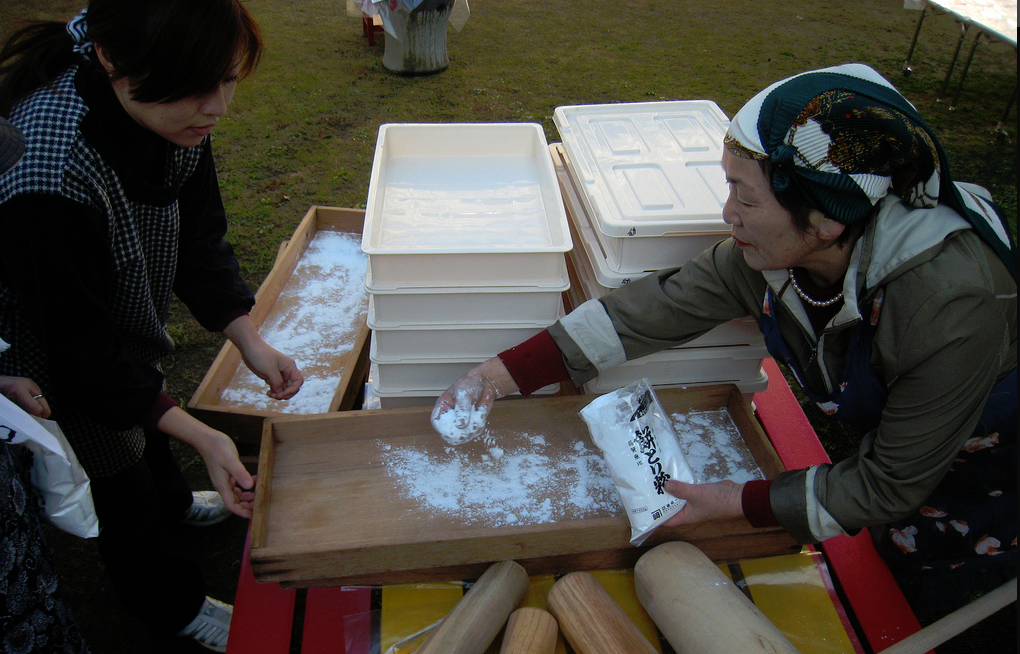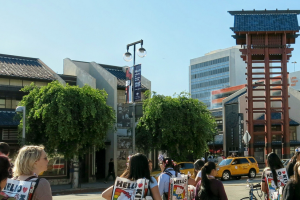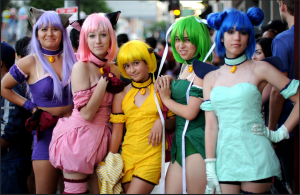
By Mandy Day
When the rice flour flies and families and communities come together in the annual tradition of mochi making, or mochitsuki, the celebration of Oshogatsu is upon us. Celebrated on January 1st, Japanese people around the world congregate to eat and enjoy the company of family and friends for one of the year’s biggest holidays. Last year’s article, found here, focused on the traditions of Oshogatsu and how individuals celebrated. As I sit in the rural upstate of South Carolina, yet again missing out on the delicious and fresh mochi of the West Coast, it became apparent that many Japanese Americans lack access to a community nearby where a communal celebration can occur.
For the second year in a row, I have chosen to spend the holiday season with my mother who moved from Southern California almost a decade ago to a small town near the North Carolina border. After a half dozen or so visits, the lack of access to authentic Japanese food and culture from our ancestral homeland leaves me with a strong yearning for a large scale Japanese grocer and inexpensive persimmons. After doing some internet research on New Year’s events in my mom’s area, the closest Oshogatsu events I found were in Durham, North Carolina and Atlanta. 2 1/2 hours southwest of where I currently sit, the dinner in Georgia welcoming the Year of the Monkey, is planned for January 24th by the Japan-America Society of Georgia.

Growing up in a region rich in Japanese culture, festivals occurred frequently and honored the land of my grandmother. Accessing Little Tokyo in Los Angeles was less than a ninety minute drive in the 1980s. The neighborhood that is slowly being swallowed up by the skyscrapers of downtown, I attended parades and cultural festivals with my parents and grandparents. Sukiyaki, almost as good as grandma’s, can still be found among the historic restaurants on First Street. Having grandparents in the San Jose area also afforded multiple opportunities every year to visit one of the remaining three Japantowns in the U.S. With a grandma who knew everyone, we ate well and often. Browsing through the local gift shops, picking up handmade tofu and Japanese pastries, we spent hours exploring while my first generation grandmother chatted with friends.

As our community has spread beyond the West Coast, outside of major cities, Japanese influence can be found everywhere-from the popularity of anime, to the explosion in popularity of sushi. It is safe to say that this region of South Carolina may have more Japanese restaurants than my home in North San Diego County. As a strict traditionalist with Japanese food, many of the rural Japanese establishments have been a complete shock to my old school sensibilities. Drive thrus, misnamed “hibachi” steakhouses serving a mayonnaise concoction on the side with table top cooked meats, and Japanese-Mexican fusion can all be found within a thirty minute drive of the town my mom now calls home. After two attempts, my taste buds couldn’t handle the local restaurants serving my beloved ramen and yakitori or prime beef cuts with mayonnaise. As the area begins to diversify, and Japanese corporations announce their intention to utilize affordable land and tax incentives by opening manufacturing facilities in the area, there is hope for this stubborn woman that one day she will find a thriving Japanese American community deep within the Bible Belt.
2015 is drawing to a close. We have all grown older, and hopefully, wiser. My family lost our patriarch this year. A man, who against all odds, managed to bring his Japanese wife and three children to the United States weeks before their fourth, my mother, was born. I look back on a man who embraced his wife’s Japanese culture; accompanied her around town visiting the local Japanese farmers and business people; and until the waning years of his life, called her “Ka-Chan” or the informal term for mother. One of his most important lessons, to always embrace the people and cultures we may not understand. That peace and love bring strength and renewal in our souls. Reflecting on the year’s adventures, challenges, and tragedies, my dearest Jichan was right. And that is the true spirit of Oshogatsu.

RE: Remembering the true spirit of Oshogatsu: Dear Ms. Day,
Are you a journalist? I am looking for someone who not only writes but investigates. Plenty of people writing down what Jimmy Ukegawa or a publicist tells them to write or report on the news but we are not seeing the results of any investigations. It seems like a lost art.
Mr Ukegawa’s family is part of history in So Calif. They made history with Cesar Chavez and the farmworkers movement in the 70s but not in a good way. It would be nice if that were investigated instead of him & his family being falsely portrayed as saints. (Saints who actually abused and starved workers so badly that Cesar Chavez himdelf came here to investigate.)
CT